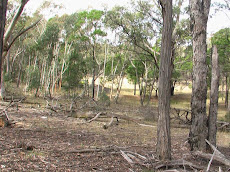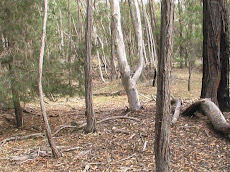Please note that this work is able to be printed off to help you if you like. All other works are copyright but the lessons can be copied and shared. Please ensure that if you share with others you recognise where you got it from.... Carol
Step 1 - gather your supplies
- Tulip in a bright pink or red - optional but it helps (you can print off my drawing and trace if you wish)

- Watercolour pencils
- Faber Castell (FC) Purple 194
- FC Burnt Carmine 193
- FC Madder 142
- FC Rose Madder Lake 128
- FC Cream 102
- FC Dark Sepia 175
- Derwent Deep Vermillion 14
- Derwent Olive Green 51
- 2B pencil
- Paintbrush (I use a size four round brush)
- Eraser
- Sharpener
- Ouline pen - I use a permanent 0.6 black pen - outlining is of course personal choice
- 300gsm rough or medium A4 size watrercolour pad (it won't buckle as the thinner papers can)
- Tissues
- Water
- Piece of extra water colour paper for scribbling and painting from later
- Glasses if you are growing ol gracefully like me!
- Tea or wine are optional extras but can help
Step 2: Outline
When drawing your flower make sure that you look at how it is put together. How do the leaves come out from the stem. what petals go underneath or over others. How are the stamens formed. All of this is important.
I make a very quick drawing first, remembering to stay within the paper....if a flower is complex I put some dots where the tips of the petals sit. This stops you going off the edge of the paper.
Using your pencil make a light drawing, erasing unneeded lines carefully. Don't rub out too often though as this destroys the way the paint reacts on the paper. You will find it easier to have your pencil fairly sharp, but dulled on the end - just scribble on a piece of paper, to achieve this. You are welcome to print off all or some of the photos in this lesson to assist you!
 Outline with a 2B pencil
Outline with a 2B pencilStep 3: Adding colour
This has to be the fun bit for me - it is a build up of colour and it doesn't only add the colour but also the light and shade. There are two things that are really important - don't be afraid to leave white patches for highlights where the light hits and experiment with surprising colours to get the effect you want. For instance I have used purple in this class to good effect - I often will use bright and dark blue in flowers as a surpriise element.
The other thing to remember is that you need to shade parts of flowers that fall underneath other parts - such as petals and leaves. This drawing is a good study of that - the leaf will help you build confidence.
Again - print off these photos if you think it will help - as you will then see the tonings.
This has to be the fun bit for me - it is a build up of colour and it doesn't only add the colour but also the light and shade. There are two things that are really important - don't be afraid to leave white patches for highlights where the light hits and experiment with surprising colours to get the effect you want. For instance I have used purple in this class to good effect - I often will use bright and dark blue in flowers as a surpriise element.
The other thing to remember is that you need to shade parts of flowers that fall underneath other parts - such as petals and leaves. This drawing is a good study of that - the leaf will help you build confidence.
Again - print off these photos if you think it will help - as you will then see the tonings.
Create the start of the shading with Burnt Carmine. Deepen the areas where the petals sit below hte others and create some outlining to give shape and form.
Continue to build up colour with Madder. Overlapping the Burnt Carmine, and as this colour is extremely vibrant, deeping the shaded areas. Leave highlights white - you can do it - don't be scared!!
Overlapping as before and adding a lighter shade into the highlighted areas.
This adds zing to the painting and is really a burst of energy - not too dark though or it will take over!!
This is a great straw colour and will highlight the stems, leaf as well as the petals.
Definitely my favourite green...... start soft and then really deepen those areas aroung the leaf so the form stands out and you can see the turnover well.
Now I know that you probably thought this is such a dark colour and I like the green just as it is. But this really gives the painting oomph! Remember with stems - highlight on one side and shade on the other. Use this colour sparingly - but it works wonders. Use it also to define the tip of the leaf.
Touches of purple really help the looseness of the painting. Carefully define the tops of the bud, where the petals overlap.
Step 4: Time for the magic
It is so amazing that a few drops of water can really make a painting glow. There are a few things to remember though:
 Start on the left hand side if you are right handed - a little area at a time. Rember little circular motions and ensure that you use your tissue for excess water.
Start on the left hand side if you are right handed - a little area at a time. Rember little circular motions and ensure that you use your tissue for excess water.

Tissue pad - use each time you load your brush with water
 Don't do adjoining areas.... leave space inbetween - I have done the two outer petals here and then I have gone back and completed the middle section
Don't do adjoining areas.... leave space inbetween - I have done the two outer petals here and then I have gone back and completed the middle section
 Competed petals
Competed petals
 The green bits
The green bits
 Touch up areas
Touch up areas
Continue to build up colour with Madder. Overlapping the Burnt Carmine, and as this colour is extremely vibrant, deeping the shaded areas. Leave highlights white - you can do it - don't be scared!!
Overlapping as before and adding a lighter shade into the highlighted areas.
This adds zing to the painting and is really a burst of energy - not too dark though or it will take over!!
This is a great straw colour and will highlight the stems, leaf as well as the petals.
Definitely my favourite green...... start soft and then really deepen those areas aroung the leaf so the form stands out and you can see the turnover well.
Now I know that you probably thought this is such a dark colour and I like the green just as it is. But this really gives the painting oomph! Remember with stems - highlight on one side and shade on the other. Use this colour sparingly - but it works wonders. Use it also to define the tip of the leaf.
Touches of purple really help the looseness of the painting. Carefully define the tops of the bud, where the petals overlap.
Step 4: Time for the magic
It is so amazing that a few drops of water can really make a painting glow. There are a few things to remember though:
- Use clean water every time for every painting
- Don't dip your brush into your tea (or wine) it is easy to do!
- Have a pad of tissues beside you and and next to your painting hand (so right if you are right handed) - this is so you don't keep taking a fully load brush over your painting to drip and ruin your work
- When you load your brush with water, place the tip on the tissue to take off excess - sucking the brush won't kill you but it isn't a gook look - especially if there is still paint on it! No blue tongue lizards here....
- Always work on section at a time and never work on adjoining petals or areas as the paint will seep into the adjoining wet section, wait about 10 minutes between working on an adjoining section
- Work in small areas, I tend to use a small circular motion for petals, strokes for stems
- Don't over work the paint, you will muddy it
- If you want a bloom effect - wet the area thoughly.... this will make the paint bloom - typically watercolours do this
- Don't go over the highlights - you can lose the highlighted areas by painting over them and the painting will become flat - highlights are good: flat is bad!
 Start on the left hand side if you are right handed - a little area at a time. Rember little circular motions and ensure that you use your tissue for excess water.
Start on the left hand side if you are right handed - a little area at a time. Rember little circular motions and ensure that you use your tissue for excess water.
Tissue pad - use each time you load your brush with water
 Don't do adjoining areas.... leave space inbetween - I have done the two outer petals here and then I have gone back and completed the middle section
Don't do adjoining areas.... leave space inbetween - I have done the two outer petals here and then I have gone back and completed the middle section Competed petals
Competed petals The green bits
The green bits Touch up areas
Touch up areasSome areas will need a little more shading using the extra water colour paper scribble a little pencil on it and use your brush to wet the paint. Add to the area and blend as necessary with a bit of extra water. Here I have used Madder and you can see the patch of paint above my hand.












